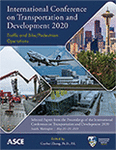International Conference on Transportation and Development 2020
Urban Area Pedestrian Accessibility Study Based on Big Data
Publication: International Conference on Transportation and Development 2020
ABSTRACT
Quantitative evaluation of urban walking traffic is an important way to optimize the layout of daily life facilities, improve the convenience of residents’ walking, ease congestion and pollution problems, and improve urban living environment. By constructing the gravity model which uses the number of different weight POIs (Building points that attract people to travel) that the urban transportation network can access within a certain distance from each building in the Yanta area, the corresponding accessibility evaluation index can be calculated and used to evaluate walking traffic. The results show that within the acceptable range of travel, the area in Yanta where the walking gravity index above 42.1 accounted for 73.2%. It shows that the overall walking accessibility of Yanta District is higher, but there is a difference in the distribution of east and west; the area in Yanta where the walking gravity index is above 24.4 accounted for 88.6%. And the distribution is even.
Get full access to this article
View all available purchase options and get full access to this chapter.
REFERENCES
[1] Hu Ruishan. Dong Suocheng. Hu Hao. A two-step Floating Catchment Area (2SFCA) Method for Measuring SpatialAccessibility to Primary Healthcare Searvice in China: A Case Study of Donghai County in Jiangsu Province[J]. Progress in Geography, 2012, 31(12): 1600-1607.
[2] Xia Yuli. Xi’an Rail Transit Accessibility Evaluation Based on Spatial Syntax and POI Transit Data——A Case Study of Xi’an City[A]. China Urban Planning Association, Dongguan Municipal People’s Government. Sustainable Development Rational Planning——2017 China Urban Planning Annual Conference Proceedings (05 Urban Planning New Technology Application) [C]. China Urban Planning Association, Dongguan Municipal People’s Government:China Urban Planning Association, 2017:13.
[3] Ma Shuhong, Ge Yong, Hu Meifang, Sun Yanhan. Highway network accessibility measurement model based on gravity model[J]. Highway transportation technology, 2018, 35(01):105-111+120.
[4] Maćkiewicz A, Ratajczak W. Towards a new definition of topological accessibility[J]. Transportation Research Part B Methodological, 1996, 30(1):47-79.
[5] Simma A, Axhausen W. Interactions Between Travel Behaviour, Accessibility and Personal Characteristics: The Case of the Upper Austria Region[J]. European Journal of Transport Infrastructure Research, 2003, 3 (2):179–197.
[6] Wang Hui, Huang Yuju, Li Yongling, Yan Xin, Xu Wangtu. Xiamen City Space Travel Convenience and Car Dependence Analysis[J]. Journal of Geographical Sciences, 2013, 68(04):477-490.
[7] Li Mengdong. Research on walking accessibility and service scope of metro station[A]. Urban and Rural Planning from the Perspective of Ecological Civilization of China Urban Planning Society——2008 China Urban Planning Annual Conference Proceedings[C]. China Urban Planning Association.
[8] Duncan D T, Aldstadt J, Whalen J, et al. Validation of Walk Score? for Estimating Neighborhood Walkability: An Analysis of Four US Metropolitan Areas[J]. International Journal of Environmental Research and Public Health, 2011, 8(12):4160-4179.
[9] Antonio Páez, Zoha Anjum, Sarah E. Dickson-Anderson, Corinne J. Schuster-Wallace, Belén Martín Ramos, Christopher D. Higgins. Comparing distance, time, and metabolic energy cost functions for walking accessibility in infrastructure-poor regions[J]. Journal of Transport Geography, 2019, 82.
[10] Xu Jian, Zhang Xinlan. Evaluation index of pedestrian network and its application [J]. Planner, 2012, 28 (04): 65-68.
[11] Liu Lianlian, Wei Wen. International Experience in Walkability Evaluation Methods and Tools [J].International Urban Planning, 2018, 33 (04): 103-110.
[12] Yang Yang, Sun Yongqing, Liu Lijun. Walkability of residential subway stations from the perspective of space barriers [J]. Urban Fast Rail Transit, 2017, 30 (05): 27-33.
[13] Long Cheng, Freke Caset, Jonas De Vos, Ben Derudder, Frank Witlox. Investigating walking accessibility to recreational amenities for elderly people in Nanjing, China[J]. Transportation Research Part D, 2019, 76.
[14] Qin Xiao, Zhen Feng, Xiong Lifang, Zhu Shoujia. Research methods of urban temporal and spatial behavior in the era of big data [J]. Progress in Geographical Sciences, 2013, 32 (09): 1352-1361.
[15] Chen Mei. Application of Big Data in Public Transport [J]. Library and Information, 2012 (06): 22-28.
Information & Authors
Information
Published In
International Conference on Transportation and Development 2020
Pages: 133 - 146
Editor: Guohui Zhang, Ph.D., University of Hawaii
ISBN (Online): 978-0-7844-8315-2
Copyright
© 2020 American Society of Civil Engineers.
History
Published online: Aug 31, 2020
Published in print: Aug 31, 2020
Authors
Metrics & Citations
Metrics
Citations
Download citation
If you have the appropriate software installed, you can download article citation data to the citation manager of your choice. Simply select your manager software from the list below and click Download.
